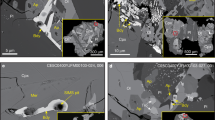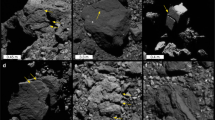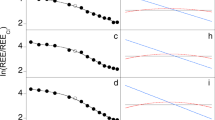Abstract
EUCRITE meteorites1 are especially important in studies of the early Solar System because they are the simplest and most ancient products of a process that was widespread in the inner Solar System2,3: basaltic volcanism. They are also the meteorites for which there is least doubt of an asteroidal origin4,5. After volcanism the eucrites experienced a period of metamorphism6, either inside the asteroid as it cooled from igneous temperatures7 or on the surface of the asteroid as a result of impact heating8. Induced thermoluminescence studies provide a new and quantitative means of determining relative metamorphic intensities for these meteorites. Using this technique, we show that the eucrites constitute a continuous metamorphic series and not, as commonly assumed, two groups of metamorphosed and non-metamorphosed meteorites9. These studies are the first application of the induced thermoluminescence technique to igneous rocks and we suggest that the method may well have application to other basalts.
This is a preview of subscription content, access via your institution
Access options
Subscribe to this journal
Receive 51 print issues and online access
$199.00 per year
only $3.90 per issue
Buy this article
- Purchase on Springer Link
- Instant access to full article PDF
Prices may be subject to local taxes which are calculated during checkout
Similar content being viewed by others
References
Duke, M. B. & Silver, L. T. Geochim. cosmochim. Acta 31, 1637–1665 (1967).
Basaltic Volcanism Study Project Basaltic Volcanism on the Terrestrial Planets (Pergamon, New York, 1981).
McSween, H. Y. A. Rev. Earth planet. Sci. 17, 117–140 (1989).
Chapman, C. R. Geochim. cosmochim. Acta 40, 701–719 (1976).
Consolmagna, G. Y. & Drake, M. J. Geochim. cosmochim. Acta 41, 1271–1282 (1977).
Miyamoto, M., Duke, M. B. & McKay, D. S. Proc. 15th Lunar planet Sci. Conf. C629–C635 (1985).
Miyamoto, M. Lunar planet. Sci. 14, 505–507 (1983).
Delaney, J. S., Prinz, M., Nehrue, C. E. & O'Neill, C. Proc. 13th Lunar planet. Sci. Conf. A339–A352 (1982).
Reid, A. M. & Barnard, B. M. Lunar planet. Sci. 10, 1019–1022 (1989).
Sears, D. W., Grossman, J. N., Melcher, C. L., Ross, L. M. & Mills, A. A. Nature 287, 791–795 (1980).
Guimon, R. K., Weeks, K. S., Keck, B. D. & Sears, D. W. G. Nature 311, 363–365 (1980).
Van Schmus, W. R. & Wood, J. A. Geochim. cosmochim. Acta 31, 747–765 (1967).
Labotka, T. C. & Papike, J. J. Proc. 11th Lunar planet. Sci. Conf. 1103–1130 (1980).
Haq, M., Hasan, F. A., Sears, D. W. G., Moore, C. B. & Lewis, C. F. Geochim. cosmochim. Acta 53, 1435–1440 (1989).
Weast, R. C. (ed.) CRC Handbook of Chemistry and Physics 66th Edn (CRC Press, Boca Raton, 1986).
Takeda, H. et al. Proc. 8th Symp. Antarctic Meteor. 181–205 (1983).
Batchelor, J. D. & Sears, D. W. G. Meteoritics (in the press).
Mason, B. in Antarctic Meteorite Newsl. (Johnson Space Center, Houston, Texas, 1978–1989) (ALHA76005, 2(1), 4(1); ALHA77302, 1(2), 1(3), 4(1); ALHA85001, 9(3); EETA79004, 3(3), 4(1); EET87452, 12(1); EET87548, 12(1); LEW85303, 9(3); LEW85305, 9(3); LEW86001, 10(2); LEW87004, 11(2); PCA82502, 6(2), 7(1)).
Steele, I. M. & Smith, J. V. Earth planet Sci. Lett. 33, 67–78 (1976).
Tera, F., Carlson, R. W. & Boctor, N. Z. Meteoritics 22, 513–514 (1987).
Jacobson, S. B. & Wasserburg, G. J. Earth planet. Sci. Lett. 67, 137–150 (1984).
Lugmair, G. W., Scheinin, N. B. & Carlson, R. W. Meteoritics 10, 300–301 (1977).
Tera, F., Carlson, R. W. & Boctor, N. Z. Lunar planet. Sci. 20, 1111–1112 (1989).
Birck, L. L. & Allegre, C. J. Earth planet. Sci. Lett. 39, 37–51 (1978).
Carlson, R. W., Tera, F. & Boctor, N. Z. Lunar planet. Sci. 19, 166–167 (1988).
Warren, P. H., Haack, H. & Rasmussen, K. L. Lunar planet. Sci. 20, 1179–1180 (1989).
Bogard, D. D. & Garrison, D. H. Lunar planet. Sci. 20, 90–91 (1989).
Delaney, J. S. Meteoritics 22, 365–366 (1987).
Hewins, R. H. Lunar planet. Sci. 21, 509–510 (1990).
Harlow, G. E. & Klimentidis, R. Proc. 11th Lunar planet. Sci. Conf. 1131–1143 (1980).
Mason, B. et al. Smithson. Contrib. Earth Sci. 23, 36–38 (1979); 24, 38–43 (1982); 26, 41–44 (1984); 28, 50–53 (1989).
Batchelor, J. D. & Sears, D. W. G. Lunar planet. Sci. 20, 52–53 (1989).
Sears, D. W. G., Sears, H. & Myers, B. M. Lunar planet. Sci. 21, 1121–1122 (1990).
Author information
Authors and Affiliations
Rights and permissions
About this article
Cite this article
Batchelor, J., Sears, D. Metamorphism of eucrite meteorites studied quantitatively using induced thermoluminescence. Nature 349, 516–518 (1991). https://doi.org/10.1038/349516a0
Received:
Accepted:
Issue Date:
DOI: https://doi.org/10.1038/349516a0
Comments
By submitting a comment you agree to abide by our Terms and Community Guidelines. If you find something abusive or that does not comply with our terms or guidelines please flag it as inappropriate.



